HttpWatch Supports Firefox 3.1 Beta 3
The latest update to HttpWatch supports the recently released Firefox 3.1 Beta 3.
The latest update to HttpWatch supports the recently released Firefox 3.1 Beta 3.
![]() February 10, 2009 in
Automation , Firefox , HttpWatch
February 10, 2009 in
Automation , Firefox , HttpWatch
One of the interesting new features in Google’s Chrome browser is the use of one Windows process per site or tab. This helps to enforce the isolation between tabs and prevents a problem in one tab crashing the whole browser.
In comparison, Firefox seems to have a simplistic process model on Windows. It doesn’t matter how many tabs or windows you open, or how many times you start Firefox – by default you get one instance of firefox.exe:
In Internet Explorer you can create a separate instance of the browser process just by starting another copy of iexplore.exe.
There are advantages to Firefox’s single process model:
However, the lack of isolation means that if anything causes a page to crash, you’ll lose all your Firefox tabs and windows. This is mitigated to some degree by Firefox’s ability to restart the browser and reload the set of pages displayed in the previous session.
So what do you do if you are developing an add-on for Firefox or you want to run automated tests in Firefox whilst still using Firefox to browse in the normal way?
In Firefox, multi-process support is provided through the use of profiles. When Firefox is installed, you automatically get one default profile that contains user settings, browsing history, the browser cache and persistent cookies. Additional profiles can be created using the Firefox Profile Manager.
The Profile Manager is built into Firefox and is started by running this command in Start->Run:
firefox -P -no-remote
The -P flag indicates that the Profile Manager should be started and the -no-remote flag indicates that any running instances of Firefox should be ignored. If you run without this flag and you have already started Firefox, the command will simply open a new Firefox window without displaying the Profile Manager.
The Profile Manager has a simple user interface that allows you to create, delete and rename profiles:
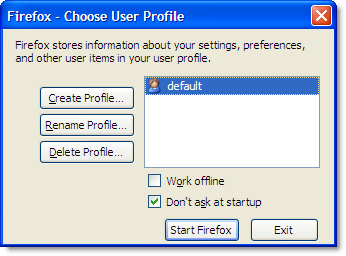
You can start Firefox in a non-default profile by using the following command line:
firefox -P <myprofile> -no-remote
For example, if you created a new profile called AutoTest:
You could set up a shortcut like this to start Firefox in the AutoTest profile:
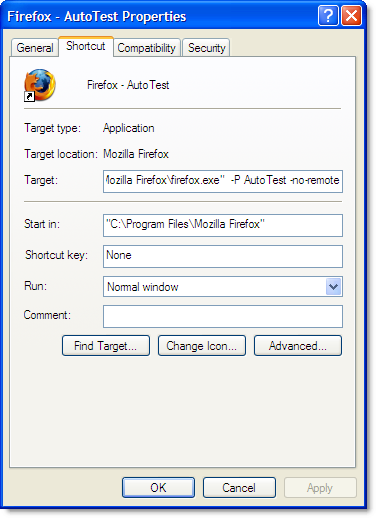
Each profile uses its own copy of the firefox.exe process, as well as its own settings, browser cache, history and peristent cookies. This provides more isolation than you would achieve by running multiple processes in IE. You can even separately enable or disable add-ons like Firebug or HttpWatch in each profile.
Internet Explorer’s cache and persistent cookies are maintained on a per user basis making it difficult to run separate instances with their own storage and settings. With Firefox you simply use different profiles. For example, you could use your default profile for normal browsing and have a separate profile to use for another purpose such as automated testing:
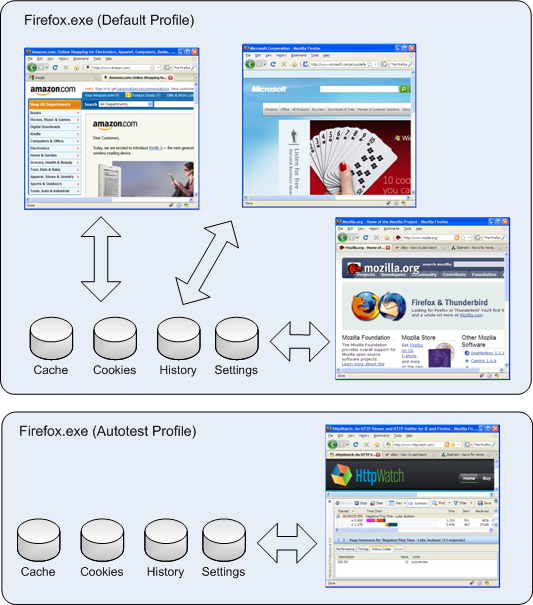
The HttpWatch automation interface in version 6.0 supports the use of profiles with Firefox. The profile name can be passed to the Attach and New methods of the Firefox plugin object. Passing an empty string indicates that you want to use the default profile.
Here’s a modified version of the page load test that we previously featured. It’s written in C# and uses a non-default profile to run the test:
// Set a reference to the HttpWatch COM library // to start using the HttpWatch namespace using HttpWatch; namespace EmptyCacheTest { class Program { static void Main(string[] args) { string url = "http://www.httpwatch.com"; string profileName = "AutoTest"; Controller controller = new Controller(); // Create an instance of Firefox in the specified profile Plugin plugin = controller.Firefox.New(profileName); // Clear out all existing cache entries plugin.ClearCache(); plugin.Record(); plugin.GotoURL(url); // Wait for the page to download controller.Wait(plugin, -1); plugin.Stop(); // Find the load time for the first page recorded double pageLoadTimeSecs = plugin.Log.Pages[0].Entries.Summary.Time; System.Console.WriteLine( "The empty cache load time for '" + url + "' was " + pageLoadTimeSecs.ToString() + " secs"); // Uncomment the next line to save the results // plugin.Log.Save(@"c:\temp\emptytestcache.hwl"); plugin.CloseBrowser(); } } } |
![]() January 15, 2009 in
Caching , Firefox , HTTP , HTTPS , HttpWatch , Internet Explorer , Optimization
January 15, 2009 in
Caching , Firefox , HTTP , HTTPS , HttpWatch , Internet Explorer , Optimization
An often overlooked aspect of web performance tuning is the effect of using the HTTPS protocol to create a secure web site. As applications move from the desktop onto the web, the need for security and privacy means that HTTPS is now heavily used by web sites that need to be responsive enough for every day use.
The tips shown below may help you to avoid some of the common performance and development problems encountered on sites using HTTPS:
Whenever a browser accesses a web site it must create one or more TCP connections. That can be in lengthy operation even with normal unsecured HTTP. The use of Keep-Alive connections reduces this overhead by reusing TCP connections for multiple HTTP requests. The screen shot below from HttpWatch shows the TCP connection time over HTTP is approximately 130 milliseconds for our web site when it is accessed from the UK:
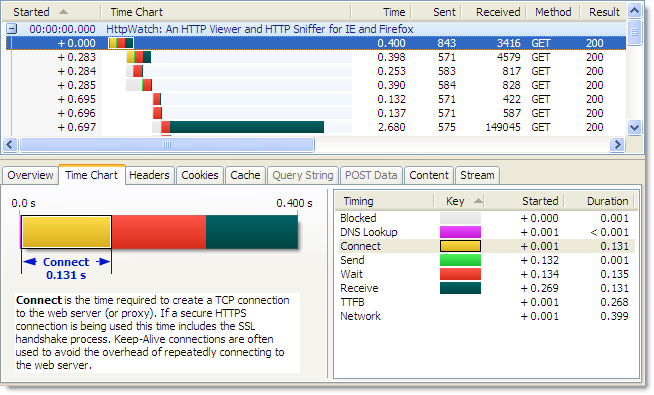
Using HTTPS, the lack of Keep-Alive connections can lead to an even larger degradation in performance because an SSL connection also has to be setup once the TCP connection has been made. This requires several roundtrips between the browser and web server to allow them to agree on an encryption key (often referred to as the SSL session key) . The corresponding connection time to the same server using HTTPS is nearly four times longer as it includes the HTTPS overhead:
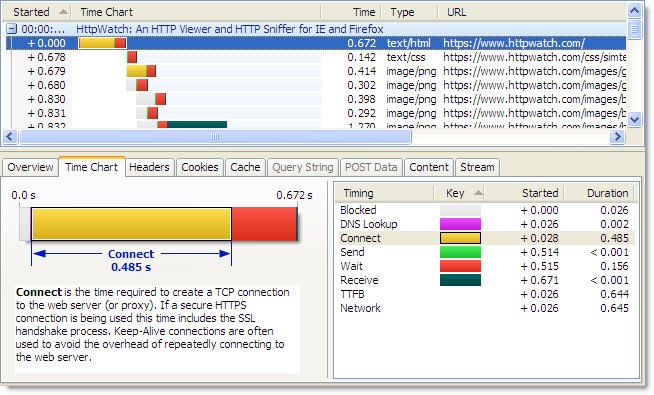
If a HTTPS connection is re-used the overhead of the both the TCP connection and SSL handshake are avoided.
Some web browsers and servers now allow the re-use of these SSL session keys across connections, but you may not always have control over the web server configuration or the type of browser used.
In a previous blog post we talked about the confusing and annoying dialog that is displayed by default if a secure page uses any HTTP resources:

To stop this warning dialog interrupting the page download you need to ensure that everything on the page is accessed over HTTPS. It doesn’t have to be from the same site but it must use HTTPS. For example, the addition of HTTPS support allows the Google Ajax libraries to be safely loaded from secure pages.
If you follow Tip #2 then everything that your page needs, including images, CSS and Javascript, will be accessed over HTTPS. You would normally want to persistently cache static content like this for as long as possible to reduce load on the web site and improve performance when a user revisits your site.
Of course, you wouldn’t want to cache anything on the disk that was specific to the user (e.g. HTML page with account details or a pie chart of their monthly spending). On most pages though, nearly all of the non-HTML content can be safely stored, shared and re-used.
There seems to be some confusion over whether caching is possible with HTTPS. For example, Google say this about Gmail over HTTPS:
You may find that Gmail is considerably slower over the HTTPS connection, because browsers do not cache these pages and must reload the code that makes Gmail work each time you change screens.
Although, 37Signals acknowledge that in-memory caching is possible, they say that persistent caching is not possible:
The problem is that browsers don’t like caching SSL content. So when you have an image or a style sheet on SSL, it’ll generally only be kept in memory and may even be scrubbed from there if the user is low on RAM (though you can kinda get around that).
Even when you do your best to limit the number of style sheets and javascript files and gzip them for delivery, it’s still mighty inefficient and slow to serve them over SSL every single time the user comes back to your site. Even when nothing changed. HTTP caching was supposed to help you with that, but over SSL it’s almost all for naught.
In reality, persistent caching is possible with HTTPS using both IE and Firefox.
Using HttpWatch you can see if content is loaded from the cache by looking for (Cache) in the Result column or by looking for the blue Cache Read block in the time chart. Here is an example of visiting https://www.httpwatch.com with a primed cache in IE. You can see that all the static resources are reloaded directly from the cache without a round trip to the web server:
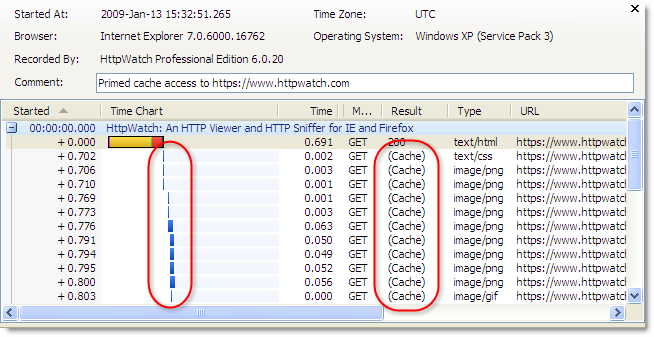
If you try this in Firefox 3.0 without adjusting your response headers you will see this instead:
The ‘200’ values in the Result column indicate that the static content is being reloaded even though the site was previously visited and a valid Expires setting was used. Unless you specify otherwise, Firefox will put HTTPS resources into the in-memory cache so that they can only be re-used within a browser session. When Firefox closes the contents of the in-memory cache is lost.
The about:cache page in Firefox confirms that these files are stored using the in-memory cache:
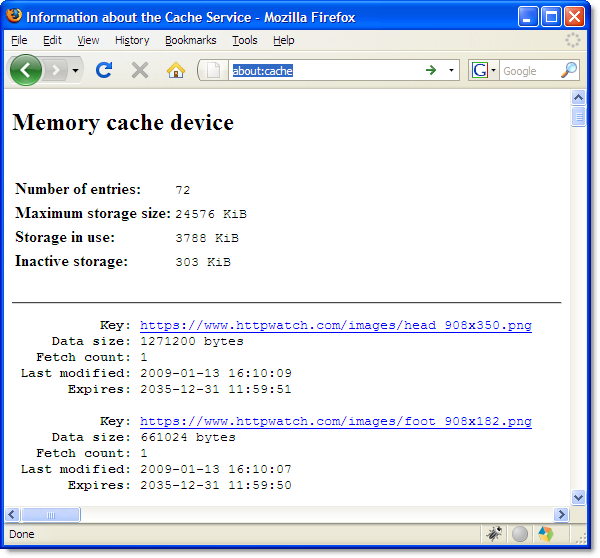
To allow persistent caching of secure content in Firefox you need to set the Cache-Control response header to Public:
This value moves HTTPS based content into the persistent Firefox disk cache and in the case of https://www.httpwatch.com it more than halves the page load time due to the decrease in network round trips and TCP/SSL connections:
The Public cache setting is normally used to indicate that the content is not per user and can be safely stored in shared caches such as HTTP proxies. With HTTPS this is meaningless as proxies are unable to see the contents of HTTPS requests. So Firefox cleverly uses this header to control whether the content is stored persistently to the disk.
This feature was only added in Firefox version 3.0 so it won’t work with older versions. Fortunately, the take up version 3.0 is reported to be much faster than IE 6 to 7.
 A network sniffer is an invaluable tool for optimizing and debugging any client server application. But if you use a network level tool like Netmon or WireShark you cannot view HTTPS requests without access to the private key that the web site uses to encrypt SSL connections.
A network sniffer is an invaluable tool for optimizing and debugging any client server application. But if you use a network level tool like Netmon or WireShark you cannot view HTTPS requests without access to the private key that the web site uses to encrypt SSL connections.
Often organizations will not allow the use of private keys outside of a production environment, and even if you have administrative access to your web site, getting the private key and using it to decrypt network traffic is not an easy task.
HttpWatch was originally born out of the frustration of trying to debug secure sites. Viewing HTTPS traffic in HttpWatch is easy as it integrates directly with IE or Firefox, and therefore has access to the unencrypted version of the data that is transmitted over HTTPS.
The free Basic Edition shows high level data and performance time charts for any site, and lower level data for a number of well know sites including Amazon.com, eBay.com, Google.com and HttpWatch.com . For example, you can try it with HTTPS by going to https://www.httpwatch.com .